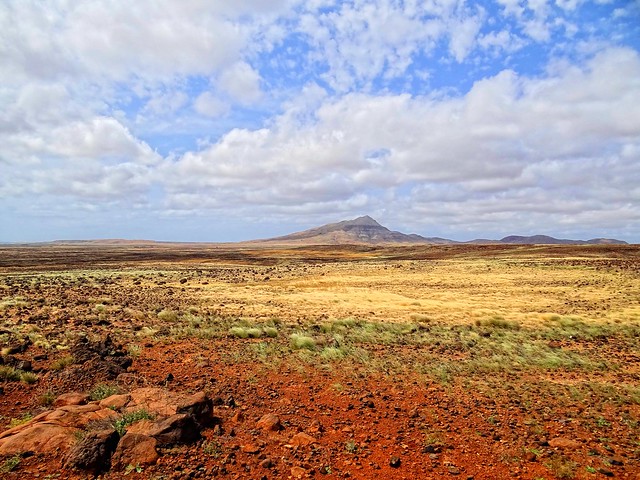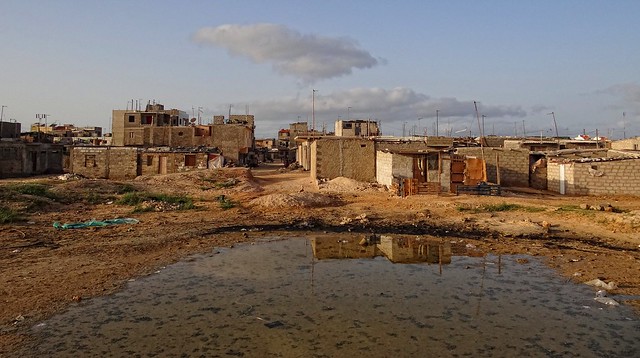 |
| Is this my basic hotel with a swimming pool? Not necessarily. |
The village has a population of only six thousand or so, so it doesn't have more than just a few facilities. There's a barber that charges three Euro for a haircutr. And there are a few shops, where most of the items on sale are cheap imports from China. "Gleat qality goodds!", the shopkeepers proudly claim, pretty much all of them being Chinese as well. If there is a more certain way to tell that you're now in proper Africa, then I don't know about it. Except for great herds of wildebeest and zebras, of course. But they aren't very good swimmers, so there aren't any of those in Cape Verde, located 570 kilometres off the western coast of North Africa.
 |
| Cape Verdean Wilderness |
Other islands in the Cape Verde archipelago are very different, but Boa Vista seems to be just a collection of rocks put on top of some meager pasture. Which is fine, but it certainly keeps the temperatures down. Having experienced the heat of Senegal and The Gambia, that feels like a blessing. Still, do bring sunscreen. Lots of sunscreen!
I felt completely safe on tiny Boa Vista. That is, until the police came over and warned me to really be careful. I don't know how real the threat is, but the advice given was to avoid walking alone, especially on deserted beaches. You would think that with just six thousand or so people around, it should be possible to shake out the bad seeds, but apparently they have problems with that. Typical foreigners! Nah. I bet they're just like everyone else, there's a small risk that bad things can happen here, just like anywhere else, yet most of the people you will meet are nice ones.
 |
| A friendly, yet unpredictable neighbourhood in Sal Rei, Cape Verde |
Inside and near the village of Sal Rei, however, I can imagine that some strange and not necessarily only pleasant things can happen. Behind the fairly proper buildings along the streets near the waterfront, I found a total poor people's ghetto, fairly new but still rapidly decaying. All the buildings have tin roofs and walls of concrete blocks, laundry with numerous holes hanging on the roof and garbage floating on the ground. It didn't seem like they had connected to the electrical grid and the sewer system quite yet. After sunset it got really, really dark there, and if you step into a turd, it's origin may well not be of the canine kind, to put it that way.
Mind you, everyone I met were happy, polite and smiling, waving at me and saying hello. Still, when lots of people live like that, there's bound to be a few of them seeing the potential in having relatively rich European walking around their home.
The best day during my week on Boa Vista was probably when I rented a car and drove around the whole island. Or maybe it wasn't so much a car, but more a small tank with four-wheel drive and some pretty impressive battle wounds on the sides, the front and the back.
The rental lady gave me a faint map of the island, with some strange dotted lines that looked like they could just as well be stream beds as roads. When I left civilization, I discovered that some of them actually were rivers AND roads. To get to the spots I thought would be most interesting to see, I just had to drive wherever the ground looked least threatening, whether there were any wheel tracks there or not. Great fun, but a bit exhausting after a while.
 |
| Not built by the old Romans, it just looks like it was. |
I barely saw another car throughout the day, so I was really glad the engine made it back to Sal Rei. As the only car on eastern Boa Vista, I was a pleasant encounter for a shepherd there who wanted to hitch-hike a bit. He didn't seem to know exactly where he was going, but he was beaming with joy from sitting in a car.
After a while he suddenly asked me to stop and said "Whoa! I have to go over there and check out those goats. I'll be back in a few minutes!". To make sure I didn't take off again without him, he left behind an ancient leathery backpack, presumably filled with his greatest earthly treasures. He returned, we continued, and a little while later he decided he had been sitting in a car enough for that day, and walked out into the wilderness again.
All in all, my week on Boa Vista was fine, although certainly not spectacular. It's just enough time to get used to all the stray dogs, to try all the courses served in the little outdoor restaurant in the town square, and to learn the names of all the "artists" from Senegal and Guinea-Bissau who patrol the streets in search of tourists willing to buy works from their home villages on the African mainland. Maybe the Chinese running the shop in the corner store has learnt your name as well, having initiated some conversation after you have stumbled into his shop a few times in search of bottled water and salty chips for rehydration following your long, warm walks.
 |
| A man and his dog |
Ok, so maybe that means you will have to endure a few authentic power outages and a Friday and Saturday night filled with helplessly melancolic dance music coming from accordions and drums very close to your room, but that's not really a big problem. You should still sleep better there than in a large hotel, knowing that the money you spend are going almost straight into the pockets of people who really need the wealth you bring, instead of being exported to some hotel chain's bank account in a far-away tax haven.
If you just want warm and sunny weather, and you're tired of the Mediterranean and the Canary Islands, Cape Verde will do the job for you. If, however, you travel with lots of dining and shopping in mind, I think you'd better head elsewhere. Unless you collect African drums, postcards turning yellow, or small wooden figurines made from endangered species of trees, that is. They've got plenty of those.
Summing up my experience: Decent place to go for a week, but I'll probably not return.